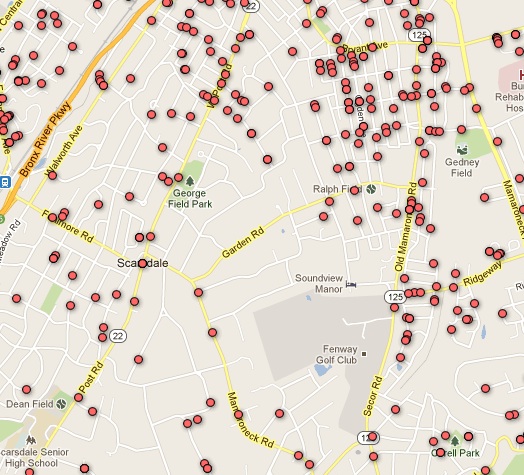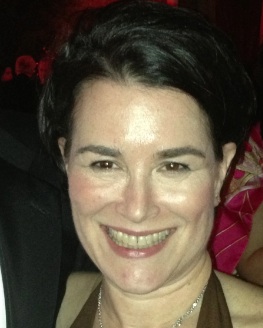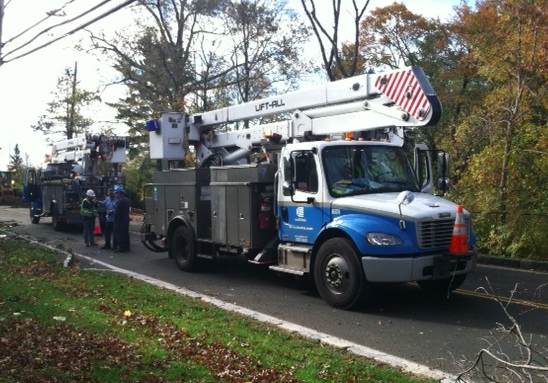Local Control of Gun Control
- Details
- Written by Joanne Wallenstein
- Hits: 3880
 Even though the Newtown shootings ignited a passion for stricter gun control, from everything I see and hear it's going to be very difficult to pass meaningful legislation to prevent another tragedy. With 310 million guns already in the homes of Americans and ammo too numerous to quantify, guaranteeing our safety may prove to be impossible.
Even though the Newtown shootings ignited a passion for stricter gun control, from everything I see and hear it's going to be very difficult to pass meaningful legislation to prevent another tragedy. With 310 million guns already in the homes of Americans and ammo too numerous to quantify, guaranteeing our safety may prove to be impossible.
Even if Congress passes a ban on the sale of assault weapons, what about the millions of guns already out there and the endless rounds of bullets stored in peoples' homes? Though I support any measure to limit gun sales, to enforce stricter licensing requirements and to raise the cost of ammunition, I fear that legislation alone is not the answer to this terrible predicament we're in.
And if we can't depend on national authorities to correct the mess they made, how about seeking a local solution? After the publication of the map of those with gun licenses in the Journal News, conversations have grown heated from those who fear for their safety and others who defend their right to own a gun and store it in their homes. Despite the fact that there has not been an armed robbery in town for years and it's been shown that a gun in the house is more likely to be used against family members than to protect them, some feel strongly that the Second Amendment gives them the right to bear arms.
So while we wait for Congress to debate how to keep us safe, how about making a symbolic statement here in town? Let's declare Scarsdale a gun-free zone and ask those who have guns in their homes to bring them to the police station to be stored for safekeeping. When they need their guns to shoot deer they can go to the station and take them out for a limited time. Just as we store our jewels in the safe deposit box at the bank, we can store our guns with the authorities to assure that they don't fall into the wrong hands.
Though we can't pass a law to require this, we can implement a public service campaign to encourage it. And hopefully peer pressure and the sense of community will inspire residents to store their guns at the Public Safety Building, rather than in their nightstands. I believe many would be proud to say they live in a community that doesn't accept guns as a way of life.
Grassroots movement such as Mothers Against Drunk Driving (MADD) and the Race to Nowhere – an anti-homework movement -- have been highly effective at getting the word out about their causes. Declaring Scarsdale a gun-free zone could send a message to neighboring communities and beyond, and begin to limit the risk that guns will be misappropriated by disturbed gunmen like Adam Lanza.
No, it's not the solution to the gun quandary, but it is a good place to start.
Interactive Map of Local Gunowners Now Available
- Details
- Hits: 8084
 Last week when we floated the idea of publishing the list of gun owners in Scarsdale, we were flooded with disparaging comments. In response to the article, Does Your Neighbor Have a Gun? on Scarsdale10583.com, one reader called the notion "Insane. Stupid. Idiotic." Another said, "What makes this country great is the right to privacy and the right of law-abiding people to own firearms should they choose," and another got personal, saying, "Does Joanne Wallenstein have any experience with firearms? I bet Ms. Wallenstein has never fired a gun... but now she's an expert on gun control? BTW - there is NO gun register. Guns don't kill people... people kill people."
Last week when we floated the idea of publishing the list of gun owners in Scarsdale, we were flooded with disparaging comments. In response to the article, Does Your Neighbor Have a Gun? on Scarsdale10583.com, one reader called the notion "Insane. Stupid. Idiotic." Another said, "What makes this country great is the right to privacy and the right of law-abiding people to own firearms should they choose," and another got personal, saying, "Does Joanne Wallenstein have any experience with firearms? I bet Ms. Wallenstein has never fired a gun... but now she's an expert on gun control? BTW - there is NO gun register. Guns don't kill people... people kill people."
It turns out there is a list of those with pistol permits. Now, just a few days after our piece appeared the Journal News has published a map showing the names and addresses of all registered gun owners in Westchester and Rockland Counties. We don't know if they got the idea to request the information from Scarsdale10583 as they give no credit to the site – however, whether by coincidence or happenstance, the information is now available to the general public.
According to the article, there are 44,000 gun owners in the two counties, meaning one out of 23 adults are licensed to own a handgun. While the list does provide the names and addresses of the gun owners, it does not provide information about the types of guns that are owned or how many guns each owner has in his or her possession.
The information was obtained by filing a FOIL (Freedom of Information Law) request and the newspaper used the data to compile and interactive map showing where gun owners reside. According to the NY Times, publication of this information has caused an outcry and many are upset over their loss of privacy.
where gun owners reside. According to the NY Times, publication of this information has caused an outcry and many are upset over their loss of privacy.
Take a look here to see who has a pistol permit on your street. You may be surprised. And continue to send us your comments on this clearly "loaded" issue.
See a live discussion about guns and your neighbors with Joanne Wallenstein on Huffington Post live:
Scarsdale Residents Raise Funds for Good Causes
- Details
- Hits: 4819
 Some 65 women gathered recently at the home of Scarsdale resident Linda Plattus to enjoy lunch and contribute holiday gifts for children served by Westchester Jewish Community Services (WJCS). A WJCS Board member, Ms. Plattus has organized this luncheon for eight years for the annual WJCS Have-a-Heart for the Holidays Gift Drive. At this year's event, 425 toys and more than $1,400 in gift certificates were collected to help fulfill holiday wishes. The items will be distributed to families in need served by WJCS, which sponsors more than 80 programs throughout Westchester. Contributing to the success of the event were several local businesses including Standing Room Only, Lange's Deli, Martine's Fine Bake Shoppe, Cherry Lawn and House of Flowers. WJCS welcomes donations of various items throughout the year. To donate goods or funds, contact Meryl Lewis at 914-761-0600 ext. 222. For more information about WJCS, visit www.wjcs.com.
Some 65 women gathered recently at the home of Scarsdale resident Linda Plattus to enjoy lunch and contribute holiday gifts for children served by Westchester Jewish Community Services (WJCS). A WJCS Board member, Ms. Plattus has organized this luncheon for eight years for the annual WJCS Have-a-Heart for the Holidays Gift Drive. At this year's event, 425 toys and more than $1,400 in gift certificates were collected to help fulfill holiday wishes. The items will be distributed to families in need served by WJCS, which sponsors more than 80 programs throughout Westchester. Contributing to the success of the event were several local businesses including Standing Room Only, Lange's Deli, Martine's Fine Bake Shoppe, Cherry Lawn and House of Flowers. WJCS welcomes donations of various items throughout the year. To donate goods or funds, contact Meryl Lewis at 914-761-0600 ext. 222. For more information about WJCS, visit www.wjcs.com.
(Pictured left to right, bottom to top) Scarsdale residents Dina Braun, Linda Plattus, Carol Kushnick, Jocelyn Sontag, Shari Schneider, Carrie Banks, Amy Brief, Allison Strassberg and Diane Greenwald with some of the gifts collected at the recent luncheon to benefit the Have-a-Heart for the Holidays Gift Drive sponsored by Westchester Jewish Community Services (WJCS).

On Tuesday, October 9, 2012 at the Quaker Ridge Golf Club, the Scarsdale PBA held their annual charity event to raise money to benefit the Hemophilia Association of New York (HANY), and Navigating the Spectrum (Autism support). They were able to raise $23,000 for both charities. This golf outing has been a major success throughout the years. This is the Scarsdale PBA's eighth year and sold out 144 golfers in just 11 days due to everyone's support and generosity. The check giving ceremony was held on Wednesday, December 12th,at Zachys Wine and Liquor in Scarsdale. Zachys President, Jeff Zacharia and CEO, Don Zacharia accepted the check on behalf of The Hemophilia Association of NY (both of whom are on the board) and Betty Davidson accepted the check on behalf of Navigating the Spectrum.
Photo: Don Zacharia (Zachys CEO), Jeff Zacharia (Zachys President), Ronnie Arefieg (Scarsdale PBA), Betty Davidson (Navigating The Spectrum)
In the Face of Heartbreak, a Sandy Hook Action Path
- Details
- Hits: 13539
 The following was submitted by Scarsdale resident Sharon Dizenhuz a former reporter and anchor on New York 1 News and a mother of children in the Scarsdale schools: Like so many of you, I cannot stop thinking about this devastating horror in Connecticut. As a mother, my heart returns again and again to the excruciating agony we all feel for the tiny little lives snuffed out, the milestones missed, and the searing pain of the parents who have lost their beloved babies. But as a journalist, my head keeps asking...what is the "Week in Review" story here? what is the "Takeaway"?
The following was submitted by Scarsdale resident Sharon Dizenhuz a former reporter and anchor on New York 1 News and a mother of children in the Scarsdale schools: Like so many of you, I cannot stop thinking about this devastating horror in Connecticut. As a mother, my heart returns again and again to the excruciating agony we all feel for the tiny little lives snuffed out, the milestones missed, and the searing pain of the parents who have lost their beloved babies. But as a journalist, my head keeps asking...what is the "Week in Review" story here? what is the "Takeaway"?
Certainly, it is not the tragic shipwreck of HE WHO SHALL REMAIN NAMELESS. With his murderous rampage, he forfeited his right to our attention. He does not deserve the repugnant sort of de facto glorification attendant to being among the worst kind of "biggest losers". The lead, the real story here, is much bigger than one sad genius with a screw loose. It is all the steps along the way from pubescent pocket-protector geek, to executioner during which we as a society might have interceded, during which we let him down, and by default, during which we laid bare our cherished children and the cherished children of our neighbors.
There are so many factors that we need to take into account as we try to absorb the shock of this horror, move forward, and attempt to make sense of the senseless. And the answers are not any one of the many pat, reflexive, reactive responses being spewed all around the blogosphere.
It seems to me that we need to take a step back and do some work to rejigger our national culture (which glorifies violence and celebrity, and then accords a twisted kind of dark fame to those who perpetrate epically destructive violent acts).
We need to revisit our childrearing values (which currently tacitly embrace texting-- shorthand Morse code of sorts on digital devices as the primary form of human contact for so many young developing minds and hearts. How many young people are even comfortable having a conversation from the heart with another person while actually looking them in the eye these days? Precious few. But heart to heart and face to face is how we connect as human beings. This is how we stave off loneliness and isolation, and a sense of hopelessness that can spin out of control in the non-resilient. We need to get back to talking face to face to our fellow humans on meaningful topics. Voice to voice. Person to person. We need to get back to talking.....AND listening. And yes, you should pardon the expression for any koom-ba-ya associations it might have for you.....hugging. Text messages, aims, bbms, etc have nothing on the good old healing touch as a salve for the splintered soul.
We need to reconsider our sense of community (sorely lacking in our winner-take-all individualist society) and to teach our children the importance of collaboration, coping with frustration, building resilience, encouraging the willingness to take good risks and try new ways of learning without giving in to crippling fear of failure. Independent thinking and the capacity for collaboration are strong paths to success, and a track record of success builds the kind of confidence an unemployed 20 year-old dropout living with Mom doesn't tend to have.
We need to seriously revamp our regulations of gun control (where an affluent, affable, mah-johng-playing garden-loving single mom in the exurbs with a mentally ill adult son in residence can still buy a cache of semi-automatic weapons and not be required to keep them off-premises and under lock and key.) If it did not occur to this ostensibly bright and well-educated woman that having an arsenal within reach of her irate and irrational tinderbox of a son was a bad idea, then perhaps it shouldn't have been up to her to decide if she needed all that firepower.
And finally, we need to create a true community, a VILLAGE (to turn a phrase....), where a family with a child who is smart but at-risk, angry, and in desperate need of a diagnosis and an action plan can seek or, if need be, be encouraged to seek the kind of help that keeps a future serial killer from slipping through the cracks. We need to work to remove the stigma of mental illness so that treating it can be regarded as simply and directly as treating any other disorder, so simmering cauldrons don't overflow. We need to educate parents and teachers to recognize warning signs, and create a culture where both are comfortable taking steps to address them before a warning sign becomes obvious only in retrospect.
This is way, way, bigger than simple gun control.
I heard a report today that, at most, half of the guns that are sold in this country are sold through the "proper" and conventional legal channels. This means that even if the regulations were to change, it would be virtually irrelevant to the firearms market unless the whole gun show and black market pieces of the equation were somehow reduced to irrelevance. That means a culture change. Regulations can't fix that alone. Before we even think about that, we need to step back and figure out how to shift that whole firearms economic model, so the black market's market share becomes negligible. I do not know the answer to that one. Still, I couldn't help but feel grateful today to those two churches in New York that opened their doors to the city's "200 dollars back/no questions asked" program for the return of guns. I know their efforts are a drop in the bucket. But it is a start.
We need to educate parents and educators about spotting mental illness, and how and when to take steps to move toward helping and healing those who are struggling with it. We need to set up a legal system to address this before laws are broken and lives are cut short. We need to do all these things and more.... because we can no longer afford to put anyone's beloved children at risk. Because we owe it to the shattered families in Sandy Hook to help make SOMETHING positive come out of this crippling loss. I am reminded of the blog making the rounds on the internet today, written by Liza Long, (originally published in The ANARCHIST SOCCER MOM ) the brave, clear-eyed mother of a brilliant, violent, mentally ill son who is at a loss for how to help him and protect those around her. "When I asked my son's social worker for help, she said that the only thing I could do was to get Michael charged with a crime. "If he's back in the system, they'll create a paper trail," he said. "That's the only way you're ever going to get anything done. No one will pay attention to you unless you've got charges... I don't believe my son belongs in jail. The chaotic environment exacerbates Michael's sensitivity to sensory stimuli and doesn't deal with the underlying pathology. But it seems like the United States is using prison as the solution of choice for mentally ill people. According to Human Rights Watch, the number of mentally ill inmates in U.S. prisons quadrupled from 2000 to 2006, and it continues to rise—in fact, the rate of inmate mental illness is five times greater (56 percent) than in the non-incarcerated population. With state-run treatment centers and hospitals shuttered, prison is now the last resort for the mentally ill—Rikers Island, the LA County Jail and Cook County Jail in Illinois housed the nation's largest treatment centers in 2011. No one wants to send a 13-year old genius who loves Harry Potter and his snuggle animal collection to jail. But our society, with its stigma on mental illness and its broken healthcare system, does not provide us with other options."
This is our mission. We need to work together to create options for our society. We need to make MENTAL health care just as much a priority as physical health.
We cannot take away the bottomless pain of the families in Sandy Hook, no matter how much we want to. But, in addition to keeping these families in our hearts and minds this season, we owe it to them to take action, to do our level best to see that no one else need ever endure the agony that faces them in the long cold winter ahead.
Why Can't We Bury the Power Lines? A Q&A from the Scarsdale Village Board
- Details
- Hits: 9025
 In response to resident's queries about burying the power lines or seeking out alternative sources of power, the Village Board put together this informative Q&A to answer some of your most pressing questions. Read it and comment below – and if you have something controversial to say, please include your name and street address with your comment.
In response to resident's queries about burying the power lines or seeking out alternative sources of power, the Village Board put together this informative Q&A to answer some of your most pressing questions. Read it and comment below – and if you have something controversial to say, please include your name and street address with your comment.
A common comment after a storm such as Hurricane Sandy and the resultant power outages is that the power lines in the Village should be buried. Another frequent comment is that the Village should raise the money to bury the power lines. What follows in Q&A format are answers to these and related frequently asked questions. This material is not intended to be a definitive discussion of the subject but is provided with the goal of focusing on some of the issues and challenges that going forward with such a project would present.
Q: Why can't the Village bury the power lines?
A. The Village does not own the power lines. Con Ed does.
Q: Why can't the Village force Con Ed to bury the power line?
A. The Village does not have jurisdiction over Con Ed. Con Ed is subject to regulation by the New York State Public Service Commission ("PSC").
Q. Why can't the PSC force Con Ed to bury the power lines?
A. Theoretically such an order could be issued. However, such an order, if ever issued, would only be issued after appropriate hearings before the PSC in which Con Ed and other stakeholders (for example, customers, representatives of neighboring towns and the County) would appear and in which many factors, not the least of which would be the cost of such a project, would be considered. It is reasonable to expect that such a proceeding would take a considerable amount of time and among other things, if Con Ed were required to bury some or all of the power lines they would seek to pass the cost of such a project on to rate payers in the form of increases in electric rates.
Q. How much would it cost to bury the power lines in the Village?
A. In the past, Con Ed has estimated that it would cost approximately $1 million per mile to bury the power lines in the Village. Scarsdale has 91.33 miles of roads. Power lines are buried in some parts of the Village so assuming for discussion purposes that approximately 84 miles of power lines would have to buried, the cost might be in the range of approximately $84 million.
Q. During this period of low interest rates why doesn't the Village borrow the money to finance burying the power lines?
A. The power lines are not owned by the Village and so having the Village borrow the money to bury them would not make sense.
Q. So how could the cost of burying power lines be financed?
A. The logical means for financing such a project would be to have Con Ed fund it. As noted above, it would be expected that Con Ed would seek to recoup the cost of such a project through an increase of electric rates. So, ultimately the project would be funded by Con Ed customers.
Q. Can't we just change electric utilities and replace Con Ed with another provider?
A. While there are other authorized service providers selling electricity to Scarsdale customers (their names can be found on the PSC web site and in the frequent mail solicitations we all receive), the lines over which the electricity flows are still owned by Con Ed. Therefore, even though individual customers can change vendors, we would still have to deal with Con Ed on the matter of burying power lines.
Q. Could the Village amend the Village Code to require that power lines be buried and implement a program that would say, bury a portion of the lines each time a Village road was re-paved?
A. The Village Code could be so amended, but doing so would not address the fundamental issue of how to require Con Ed to put up the funds and devote the resources to a power line burying project. In addition, imposing such a requirement on existing power lines may be impractical. It may be worthwhile to consider amending the Village Code to require the burying of power lines in new Village subdivisions (a practice that is often voluntarily followed) although there are not many areas of the Village remaining that would be impacted by such a change and the change would not address the larger issue posed by the existing system.
Q. Would burying the power lines be worth it?
A. Possibly although it would not insure that there would never be power outages. For example, buried power lines remain susceptible to outages in the grid to which they are connected. Even if buried lines do not suffer a disabling event, if the grid they are connected to goes dark, the fact that the lines are underground won't matter, they'll go dark also.
In addition, buried power lines are more expensive to repair than overhead lines since it is more difficult to pin point the cause of an outage in lines that are not visible. Further, once a repair site is located, the street under which the line is buried must be excavated and repaired – an expensive and disruptive undertaking.
Q. How long would it take to bury the power lines in Scarsdale?
A. We have not seen any estimates on timing, but it would clearly be a massive undertaking requiring digging up rights of way, working around existing subsurface utilities, cutting trees and tree roots and generally disrupting the parts of the Village in which the work was being done. Assuming it was done in a piecemeal fashion, it would be expected to take many years to get the job done.
Q. Is there something else that might be done to provide a short-term cure to the problem of downed power lines that is less expensive?
A. It is not clear that there is but one area of study in this regard are the rules that govern the planting of trees in or next to the Village right of way that runs across the front of property throughout the Village. Not planting trees in or immediately next to the right of way where power poles are for the most part located would help, but of course would not solve problems caused by very large trees planted further away. In addition, consideration might be given to how trees near power lines are trimmed. In any event, this is a matter that is being studied and some work on this topic might prove helpful to some degree.
Q. Should the idea of burying power lines be abandoned?
A. Not necessarily. It may be worth pursuing in the appropriate forum – with Con Ed and at the PSC. It also may be worth pursuing a plan that would bury power lines in some areas where it might be most beneficial, but not in every part of the Village. As noted in a report of the Edison Electric Institute referred to below," [t]he future of undergrounding will continue to hinge on the ability of customers and the utilities to work together to reach a compromise on meeting customer expectations and compensating utilities for the cost of placing electrical facilities underground." Hall, Kenneth L., Out of Sight Out of Mind an Updated Study of Undergrounding Overhead Power Lines, Edison Electric Institute (December 2009)
Q. Where can I find out more information about burying power lines?
A. There is a lot of literature and news articles on the subject easily retrievable on the internet. One informative piece is a December 2009 study noted above which was prepared for the Edison Electric Institute, an electric utility trade organization. The study is available here.
In addition, a Con Ed customer can arrange to have the power line that runs from the street to the customer's home buried. While the failure of that short length of power line is rarely the sole cause of an outage in the event of a major storm, it is an exposed line that could be damaged in a storm. Some residents have had the line from the street to their home buried both for safety and aesthetic reasons. To accomplish that, a customer must hire a licensed electrician who will interface with Con Ed to get the job done. The customer must pay the cost of such a project and the cost can vary widely depending on the circumstance of each customer's house including the distance of the house from the road, nature of the terrain between the street and the house and subsurface conditions. Con Ed advises that such a project can take four to six months to complete assuming everything goes smoothly. The biggest time factor is having the job work its way up the cue of pending jobs that Con Ed may have to do at any particular time.
Q. Where do we go from here?
A. Consideration should be given to contacting Con Ed for the purpose of engaging in a project that would develop a realistic long-range plan for burying some or all of power lines in the Village. Recognizing that such a project, if doable at all, would be complex, costly and require years to put into effect, now is an appropriate time to focus on this subject in a thoughtful and constructive manner.














